InterviewSolution
This section includes InterviewSolutions, each offering curated multiple-choice questions to sharpen your knowledge and support exam preparation. Choose a topic below to get started.
| 90701. |
A colourless inorganic compound(A) is soluble in water, alcohols, amines. On strong heating (A) gives a brown gas (B) and a grey residue (C) on dissolution of(A) in NH_3 a solution (D) is formed which reduces aldehydes to form silvermirror. FeSO_4 reduces solution of (A) in water aqueous solution of(A) also gives a brick red precipitate (E) with K_2CrO_4 solution Dis |
|
Answer» `AgCrO_4` 
|
|
| 90702. |
A colourless inorganic compound(A) is soluble in water, alcohols, amines. On strong heating (A) gives a brown gas (B) and a grey residue (C) on dissolution of(A) in NH_3 a solution (D) is formed which reduces aldehydes to form silvermirror. FeSO_4 reduces solution of (A) in water aqueous solution of(A) also gives a brick red precipitate (E) with K_2CrO_4 solution C is |
Answer» Solution :
|
|
| 90703. |
A colourless inorganic compound (A) imparts a green colour to the flame. Its solution gives a white ppt. (B) with H_(2)SO_(4). When heated with K_(2)Cr_(2)O_(7) and conc. H_(2)SO_(4), a brown red vapour/gas (C) is formed. The gas/ vapour when passed through aqueous NaOH solution, it turns into a yellow solution (D) which forms yellow precipitate (E) with CH_(3)COOH and (CH_(3)COO)_(2)Pb. with reference to above information, answe the following questions. Q. The yellow ppt. formed when (D) reacts with CH_(3)COOH and (CH_(2)COO)_(2)Pb is: |
|
Answer» `PbI_(2)` 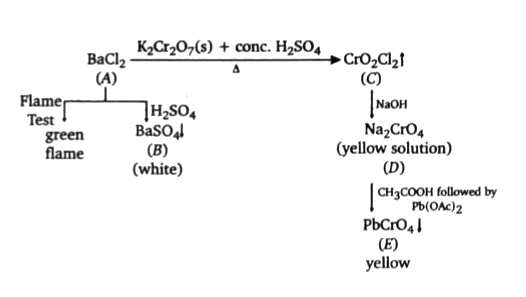
|
|
| 90704. |
A colourless inorganic compound (A) imparts a green colour to the flame. Its solution gives a white ppt. (B) with H_(2)SO_(4). When heated with K_(2)Cr_(2)O_(7) and conc. H_(2)SO_(4), a brown red vapour/gas (C) is formed. The gas/ vapour when passed through aqueous NaOH solution, it turns into a yellow solution (D) which forms yellow precipitate (E) with CH_(3)COOH and (CH_(3)COO)_(2)Pb. with reference to above information, answe the following questions. Q. The liberated gas vapour (C) is: |
|
Answer» `Br_(2)`<BR>`NO_(2)` 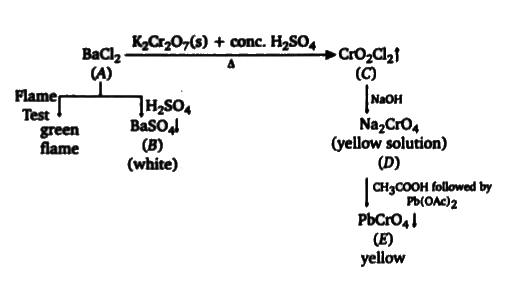
|
|
| 90705. |
A colourless inorganic compound(A) is soluble in water, alcohols, amines. On strong heating (A) gives a brown gas (B) and a grey residue (C) on dissolution of(A) in NH_3 a solution (D) is formed which reduces aldehydes to form silvermirror. FeSO_4 reduces solution of (A) in water aqueous solution of(A) also gives a brick red precipitate (E) with K_2CrO_4 solution Ais |
|
Answer» `[AG(NH_3)_2]^(+)` 
|
|
| 90706. |
A colourless inorganic compound (P) decomposes on heating to give two products (Q) and (R). (Q) is a colourless neutral gas with a sweet odour which when burnt with phosphorous produces a strong dehydrating agent (S) while (R) is a neutral liquid at room temperature. Identify P, Q, Rand S. |
|
Answer» <P> Solution :`underset"(P)"(NH_4NO_3) OVERSET(250^@C)to underset"(Q)"(N_2O) + underset"(R)"(2H_2O)``P_4 + underset"(Q)"(10N_2O) to underset"(S)"(P_4O_10) +10N_2` |
|
| 90707. |
A colourless gas with the smell of rottenn fish is |
|
Answer» `H_(2)S` `SO_(2)to` colourless gas with a pungent SUFFOCATING odour. `PH_(3)to` colourless gas with unpleasant garlic like odour or rotten fish odour. |
|
| 90708. |
A colourless gas with rotten fish small, burns spontaneously with a bright flash, giving beautiful vortex rings of white smoke is......... |
|
Answer» `P_(2)O_(3)` |
|
| 90709. |
A colourless gas which burns with blue flame and reduces CuO to Cu is: |
|
Answer» `N_2` |
|
| 90710. |
A colourless gas on passing through bromine water decolourises it. The gas is |
| Answer» ANSWER :D | |
| 90711. |
A colourless fuming liquid (A) can be prepared by passing SO_(2) over phosphorous pentachloride. The liquid can readily be hydrolysed to give sulphurous acid. The compound (A) is |
| Answer» Answer :A | |
| 90712. |
A colourless crystalline salt 'X' is soluble in dilute HCl. On adding NaOH solution, it gives a white precipitate which is insoluble in excess of NaoH. 'X' is |
|
Answer» `AL_(2)(SO_(4))_(3)` |
|
| 90713. |
A colourless (A) when place into water a heavy white turbidly of (B) solid (A) gives a close solution in conesolution in cone HCI when HCI solution is added to clear solution water ,(B) forms again (B) dissolves in dilute HCI. When H_(2)S is passed through a sespension of (A) or (B), a black precipitate (C ) forms , (C ) is insolves in yellow ammonium sulphide (NH_(4))_(2)S , cone H_(2)SO_(4) added to solid (A) liberates gas (D) gas (D) is water soluble and gives white precipitate with mercuric salts (E ) and not mercuric salt .The black precipitate (C ) dissolves in HNO_(3), (1,1) to give a solution to which H_(2)SO_(4) is added followed by addition of NH_(4)OH when a white precipitate (F) is formed (E ) gives a blackppt , (G) with solutionof sodium stannite. Compound (B ) is not soluble in |
|
Answer» Tartaric ric acid `underset((B))(BiOCI)+2HCI rarr underset((A))(BiCI_(3))+H_(2)O` `2BiCI_(3) + 3H_(2)S rarr underset("Brown-black ppt")(Bi_(2)S_(3)darr) +6HCI` `Bi_(2)S_(3) +8HNO_(3) rarr 2Bi(NO_(3))_(3) +3S darr +2NO +4H_(2)O` `2Bi(NO_(3))_(3) + 3H_(2)SO_(4) rarr Bi_(2) (SO_(4))_(3) +6HNO_(3)` `Bi_(2)(SO_(4))_(3) +6NH_(4)OH rarr underset((F))underset("White ppt") (2Bi(OH)_(3)darr) +3(NH_(4))_(2) SO_(4)` `2Bi(OH)_(3) +3Na_(2)SnO_(2) rarr underset("Black ppt")underset((G))(2Bi) +3Na_(2)SnO_(3) +H_(2)O` `2BiCI_(3) +3H_(2)SO_(4) rarr Bi_(2) (SO_(4))_(3) +underset((D))(6HCI)` `Hg_(2)(NO_(3))_(2) +2HCI rarr underset((E))underset("White ppt")(Hg_(2)CI_(2)darr)+2HNO_(3)` |
|
| 90714. |
A colourless crystalline salt, on being heated, gives a coloured gas with a pungent smell. On being passed through an AgNO_(3) solution, this gas forms a white precipitate insoluble in HNO_(3) but readily soluble in an NH_(3) solution. Which of the following reaction can lead to the above observation? |
|
Answer» `MgCl_(2)+H_(2)O to Mg(OH)Cl+HCl` |
|
| 90715. |
A colourless crystalline salt 'x' is soluble in dilute HCl. On adding NaOH solution, it gives a white precipitate which is insoluble in excess of NaOH, 'x' is |
|
Answer» `Al_(2)(SO_(4))_(3)` `MgSO_(4)+2NaOH to Mg(OH)_(2)+Na_(2)SO_(4)`. |
|
| 90716. |
A colourless compound X on treatment with alc. KOH gave a gaseous compound Y. The compound Y decolourises bromine water and alkaline KMnO_(4) solution but gives no precipitate with ammoniacal cuprous chloride. The compound X is : |
|
Answer» Ethylene <BR>Ethyne (decolourises `Br_(2)` water and alkaline `KMnO_(4)` but does not react with ammoniacal `Cu_(2)Cl_(2)`) |
|
| 90717. |
A colourless aqueous solution on adding water and on heating gave a white precipitate. The precipitate when reacted with NH_(4)Cl and NH_(4)OH in excess resulted in dissolution of some of the precipitate and a gelatinous precipitate is obtained. What is the hydroxide formed in aqueous solution? |
| Answer» Solution :`Al(OH)_(3)` is a gelatinous precipitate. | |
| 90718. |
A colourless (A) when place into water a heavy white turbidly of (B) solid (A) gives a close solution in conesolution in cone HCI when HCI solution is added to clear solution water ,(B) forms again (B) dissolves in dilute HCI. When H_(2)S is passed through a sespension of (A) or (B), a black precipitate (C ) forms , (C ) is insolves in yellow ammonium sulphide (NH_(4))_(2)S , cone H_(2)SO_(4) added to solid (A) liberates gas (D) gas (D) is water soluble and gives white precipitate with mercuric salts (E ) and not mercuric salt .The black precipitate (C ) dissolves in HNO_(3), (1,1) to give a solution to which H_(2)SO_(4) is added followed by addition of NH_(4)OH when a white precipitate (F) is formed (E ) gives a blackppt , (G) with solutionof sodium stannite. When compound (E ) reacts with NH_(4)OH , thenproduct is a |
|
Answer» White ppt `underset((B))(BiOCI)+2HCI rarr underset((A))(BiCI_(3))+H_(2)O` `2BiCI_(3) + 3H_(2)S rarr underset("Brown-black ppt")(Bi_(2)S_(3)darr) +6HCI` `Bi_(2)S_(3) +8HNO_(3) rarr 2Bi(NO_(3))_(3) +3S darr +2NO +4H_(2)O` `2Bi(NO_(3))_(3) + 3H_(2)SO_(4) rarr Bi_(2) (SO_(4))_(3) +6HNO_(3)` `Bi_(2)(SO_(4))_(3) +6NH_(4)OH rarr underset((F))underset("White ppt") (2Bi(OH)_(3)darr) +3(NH_(4))_(2) SO_(4)` `2Bi(OH)_(3) +3Na_(2)SnO_(2) rarr underset("Black ppt")underset((G))(2Bi) +3Na_(2)SnO_(3) +H_(2)O` `2BiCI_(3) +3H_(2)SO_(4) rarr Bi_(2) (SO_(4))_(3) +underset((D))(6HCI)` `Hg_(2)(NO_(3))_(2) +2HCI rarr underset((E))underset("White ppt")(Hg_(2)CI_(2)darr)+2HNO_(3)` |
|
| 90719. |
A colourless (A) when place into water a heavy white turbidly of (B) solid (A) gives a close solution in conesolution in cone HCI when HCI solution is added to clear solution water ,(B) forms again (B) dissolves in dilute HCI. When H_(2)S is passed through a sespension of (A) or (B), a black precipitate (C ) forms , (C ) is insolves in yellow ammonium sulphide (NH_(4))_(2)S , cone H_(2)SO_(4) added to solid (A) liberates gas (D) gas (D) is water soluble and gives white precipitate with mercuric salts (E ) and not mercuric salt .The black precipitate (C ) dissolves in HNO_(3), (1,1) to give a solution to which H_(2)SO_(4) is added followed by addition of NH_(4)OH when a white precipitate (F) is formed (E ) gives a blackppt , (G) with solutionof sodium stannite. Compound (C ) is alsoformedby the following reaction |
|
Answer» `Ba^(2+) + S(2)O_(3)^(2-) rarr E ` `underset((B))(BiOCI)+2HCI rarr underset((A))(BiCI_(3))+H_(2)O` `2BiCI_(3) + 3H_(2)S rarr underset("Brown-BLACK ppt")(Bi_(2)S_(3)darr) +6HCI` `Bi_(2)S_(3) +8HNO_(3) rarr 2Bi(NO_(3))_(3) +3S darr +2NO +4H_(2)O` `2Bi(NO_(3))_(3) + 3H_(2)SO_(4) rarr Bi_(2) (SO_(4))_(3) +6HNO_(3)` `Bi_(2)(SO_(4))_(3) +6NH_(4)OH rarr underset((F))underset("White ppt") (2Bi(OH)_(3)darr) +3(NH_(4))_(2) SO_(4)` `2Bi(OH)_(3) +3Na_(2)SnO_(2) rarr underset("Black ppt")underset((G))(2Bi) +3Na_(2)SnO_(3) +H_(2)O` `2BiCI_(3) +3H_(2)SO_(4) rarr Bi_(2) (SO_(4))_(3) +underset((D))(6HCI)` `Hg_(2)(NO_(3))_(2) +2HCI rarr underset((E))underset("White ppt")(Hg_(2)CI_(2)darr)+2HNO_(3)` |
|
| 90720. |
A coloured solution known to contain two metal ions, was treated with excedss cold sodium hydroxide solution. When filtered a whitish solid, slowly changing to brown, was retained on the filter paper and a colourless solution collected as the filtrate. dropwise addition of hydrochloric acid to the filtrate produced a white ppt. which dissolved in excess acid. treatment of the residue on filter paper with a solution of strong oxidier produced a reddishh-violet solution.. indicate any pairs of ions: |
|
Answer» `ZN^(2+) and MN^(2+)` IONS |
|
| 90721. |
A coloured compound (A) reacts with dilute H_(2)SO_(4) to produce a colourless gas (B) and colourless solution (C). The reaction between (B) and the acidified K_(2)Cr_(2)O_(7) solution produces a green solution and a slightly yellowise precipitate (D). the substance (D) burns in air to produce a gas (E) which also can change the colour of K_(2)Cr_(2)O_(7) solution. Q. When colourless solution (C) reacts with Pb_(3)O_(4)//H^(+), it acquires a violet red colour due to formation of |
|
Answer» `MnO_(4)^(-)` |
|
| 90722. |
A coloured compound (A) reacts with dilute H_(2)SO_(4) to produce a colourless gas (B) and colourless solution (C). The reaction between (B) and the acidified K_(2)Cr_(2)O_(7) solution produces a green solution and a slightly yellowise precipitate (D). the substance (D) burns in air to produce a gas (E) which also can change the colour of K_(2)Cr_(2)O_(7) solution. Q. When D is boiled with alkaline sulphite solution a compound F is formed. F can be used in (I) Iodine titrations in volumetric analysis (II) Bleaching industry to destroy excess Cl_(2) (III) Photography for 'fising' films (IV) Iodometric titrations Choose the correct codes |
| Answer» Answer :D | |
| 90723. |
A coloured compound (A) reacts with dilute H_(2)SO_(4) to produce a colourless gas (B) and colourless solution (C). The reaction between (B) and the acidified K_(2)Cr_(2)O_(7) solution produces a green solution and a slightly yellowise precipitate (D). the substance (D) burns in air to produce a gas (E) which also can change the colour of K_(2)Cr_(2)O_(7) solution. Q. Which is not correct about E |
|
Answer» It is COLOURLESS and higly water soluble |
|
| 90724. |
A coloured compound (A) reacts with dilute H_(2)SO_(4) to produce a colourless gas (B) and colourless solution (C). The reaction between (B) and the acidified K_(2)Cr_(2)O_(7) solution produces a green solution and a slightly yellowise precipitate (D). the substance (D) burns in air to produce a gas (E) which also can change the colour of K_(2)Cr_(2)O_(7) solution. Q. When "B" reacts with "E" |
|
Answer» A new gas F will be produced |
|
| 90725. |
A coloured compound (A) reacts with dilute H_(2)SO_(4) to produce a colourless gas (B) and colourless solution (C). The reaction between (B) and the acidified K_(2)Cr_(2)O_(7) solution produces a green solution and a slightly yellowise precipitate (D). the substance (D) burns in air to produce a gas (E) which also can change the colour of K_(2)Cr_(2)O_(7) solution. Q. "A" probably, is |
|
Answer» `ZnSO_(3)` `K_(2)Cr_(2)O_(7)+4H_(2)SO_(4)+3H_(2)S to K_(2)SO_(4) + underset((green))(Cr_(2)(SO_(4))_(3))+underset((yellow)(D))(3S)darr` `S+O_(2)tounderset((E))(SO_(2))` `K_(2)Cr_(2)O_(7)+H_(2)SO_(4)+3SO_(2)toK_(2)SO_(4)+underset((green))(Cr_(2)(SO_(4))_(3))+H_(2)O` `underset((B))(2H_(2))S+underset((E))(SO_(2))tounderset((D))(3S)darr+2H_(2)O` `Na_(2)SO_(3)+StoNa_(2)S_(2)O_(3)`  hypo solution is used as an ANTICHLOR to remove excess of `Cl_(2)` from bleached articles. `Na_(2)S_(2)O_(3)+Cl_(2)+H_(2)O to Na_(2)SO_(4)+S+2HCl` `2MN^(2+)+5PbO_(2)+4H^(+) to underset("violet red")(2MnO_(4)^(-))+5Pb^(+2)+2H_(2)O` |
|
| 90726. |
A coloured compound (A) reacts with dilute H_(2)SO_(4) to produce a colourless gas (B) and colourless solution (C). The reaction between (B) and the acidified K_(2)Cr_(2)O_(7) solution produces a green solution and a slightly yellowish precipitate (D). the substance (D) burns in air to produce a gas (E) which also cann change the colour of K_(2)Cr_(2)O_(7) solution. Q. Which is not correct about E ? |
|
Answer» It is COLOURLESS and HIGHLY water soluble 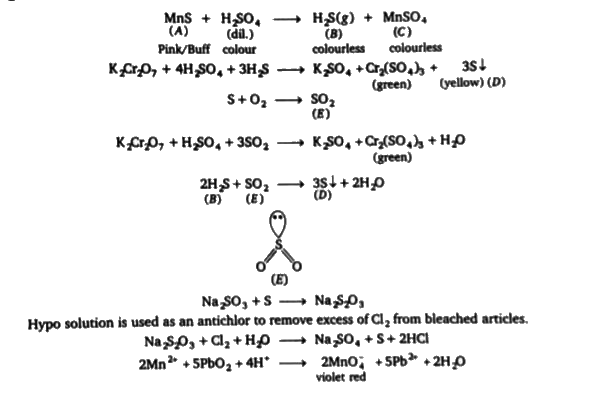
|
|
| 90727. |
A coloured compound (A) reacts with dilute H_(2)SO_(4) to produce a colourless gas (B) and colourless solution (C). The reaction between (B) and the acidified K_(2)Cr_(2)O_(7) solution produces a green solution and a slightly yellowish precipitate (D). the substance (D) burns in air to produce a gas (E) which also cann change the colour of K_(2)Cr_(2)O_(7) solution. Q. When colourless solution (C) reacts with Pb_(3)O_(4)//H^(+), it acquries a violet red colour due to formation of : |
|
Answer» `MnO_(4)^(-)` 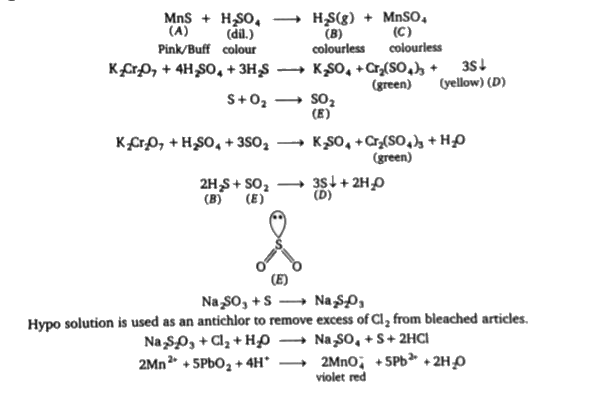
|
|
| 90728. |
A coloured compound (A) reacts with dilute H_(2)SO_(4) to produce a colourless gas (B) and colourless solution (C). The reaction between (B) and the acidified K_(2)Cr_(2)O_(7) solution produces a green solution and a slightly yellowish precipitate (D). the substance (D) burns in air to produce a gas (E) which also cann change the colour of K_(2)Cr_(2)O_(7) solution. Q. When D is boiled with alkaline sulphite solution a compound F is formed. F can be used in (I) Iodine titrations in volumetric analysis (II) Bleaching industry to destroy excess Cl_(2) (III) Photography for 'fixing' films (IV) Iodometric titrations Choose the correct codes: |
|
Answer» I and IV 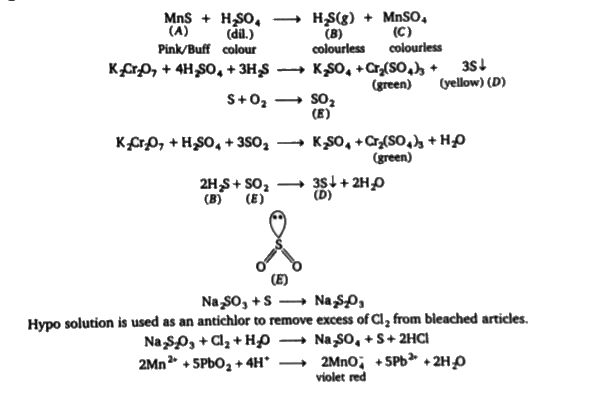
|
|
| 90729. |
A coloured compound (A) reacts with dilute H_(2)SO_(4) to produce a colourless gas (B) and colourless solution (C). The reaction between (B) and the acidified K_(2)Cr_(2)O_(7) solution produces a green solution and a slightly yellowish precipitate (D). the substance (D) burns in air to produce a gas (E) which also cann change the colour of K_(2)Cr_(2)O_(7) solution. Q. When "B" racts with "E": |
|
Answer» a NEW gas F will be PRODUCED 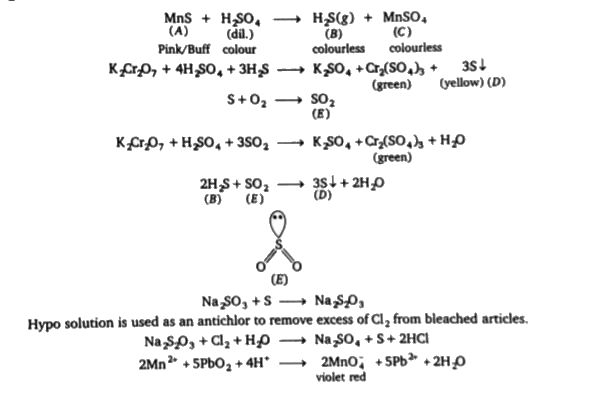
|
|
| 90730. |
A coloured compound (A) reacts with dilute H_(2)SO_(4) to produce a colourless gas (B) and colourless solution (C). The reaction between (B) and the acidified K_(2)Cr_(2)O_(7) solution produces a green solution and a slightly yellowish precipitate (D). the substance (D) burns in air to produce a gas (E) which also cann change the colour of K_(2)Cr_(2)O_(7) solution. Q. "A" probably, is: |
Answer» SOLUTION :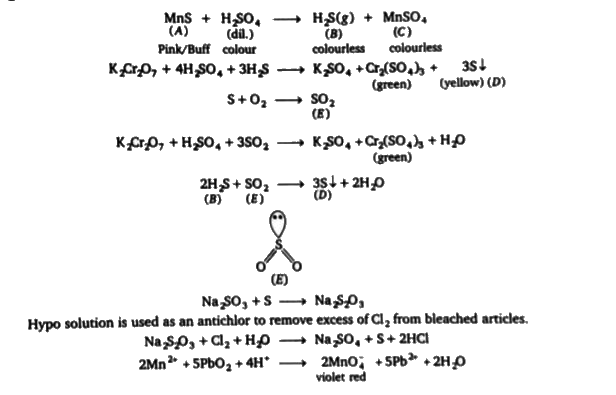
|
|
| 90731. |
A colloidal system in which the dispersed phase has very little affinity for the dispersion medium is called |
|
Answer» LYOPHILIC |
|
| 90732. |
A colloidal system in which gas bubbles are dispersed in a liquid is known as |
| Answer» SOLUTION :foam | |
| 90733. |
A colloidal system having a solid substance as a dispersed phase and a liquid as a dispersion medium is classified as ……. |
| Answer» SOLUTION :sol | |
| 90734. |
A colloidal system having a solid substance as a dispersed phase and a liquid as a dispersion medium is classified as............ |
| Answer» SOLUTION :sol | |
| 90735. |
A colloidal system having a solid substance as a dispersed phase and a liquid as a dispersion medium is classified as |
| Answer» ANSWER :D | |
| 90736. |
A colloidal system having a solid substance as a dispersed phase and a liquid as a dispersion medium is classified as……….. |
| Answer» ANSWER :D | |
| 90737. |
All colloidal solutions show : |
|
Answer» very high OSMOTIC PRESSURE |
|
| 90738. |
A colloidal system has particles of what size ? |
|
Answer» `10^-4m` to `10^-10m` |
|
| 90739. |
A colloidal solution of ferric oxide is prepared by two different methods as shown below. a. What is the charge on colloindal particles in the two test tubes (A) and (B)? b. Give reasons for the origin of charge. |
|
Answer» Solution :Colloidal PARTICLES of test tube (A) are POSITIVELY charged where as colloidal particles of test tube (B) are NEGATIVELY charged. In test tube (A). `Fe^(3+)` is adsorbed on the precipitate `Fe_(2)O_(3).xH_(2)O` [or `Fe_(2)O_(3).xH_(2)O//Fe^(3+)` is formed]. In test tube (B). `OVERSET(ɵ)(OH)` ions is adsorbed on the precipitate `Fe_(2)O_(3).xH_(2)O` [or `Fe_(2)O_(3).xH_(2)O//overset(ɵ)(OH)` is formed]. |
|
| 90740. |
A colloidal solution of arsenious sulphide is most readily coagulated by the addition of a normal solution ? |
|
Answer» `NaCl` |
|
| 90741. |
A colloidal solution of Agl is prepared by two different methods shown below: (i) What is the charge of Agl colloidal particles in the two testtubes (A) and (B)? (ii) Give reasons for the origin of charge. |
|
Answer» Solution :(i) When `AgNO_3` is added to KI solution , the ppt. of AgI will adsorb `I^(-)` ions from the dispersion medium. THUS, the colloidal particles of AgI will acquire negative charge. When KI is added to `AgNO_3` solution , the ppt. of AgI will adsorb `Ag^(+)` ions. Thus , colloidal particles of AgI will acquire positive charge. (II) Origin of charge can be explained in terms of ADSORPTION of ions from the dispersion medium and with the help of Helmholtz electrical DOUBLE LAYER. 
|
|
| 90742. |
A colloidal solution of a solid as dispersed phase and liquid as dispersion medium is known as : |
|
Answer» Gel |
|
| 90743. |
A colloidal solution is subjected to an electrical field. The particles move towards anode. The coagulation of same sol is studied using NaCl, BaCl_(2) and AlCl_(3) solutions. Their coagulating power should be |
|
Answer» `NaClgt BaCl_(2)gtAlCl_(3)` |
|
| 90744. |
A colloidal solution is subjected to an electrical field. The particles move towards anode. The coagulation of same sol is studied using NaCl, BaCl_2and AIC_3solutions. Their coagulating power should be |
|
Answer» `NACL GT BaCl_2 gt AlCl_3` |
|
| 90745. |
A colloidal solution is subjected on electrical field. The particles move towards anode. The coagulation of the same solution is studied using NaCl, BaCl_(2) and AlCl_(3) solution. Their coagulating power should be |
|
Answer» `NACL gt BaCl_(2) gt AlCl_(3)` |
|
| 90746. |
A colloidal solution in which a solid is dispersed in a liquid is called |
|
Answer» GEL |
|
| 90747. |
A colloidal solution is kept in dark and is illuminated by a beam of light then brightness appears at the right angle of direction of light. This effect is called |
|
Answer» TYNDALL effect |
|
| 90748. |
(A) Colloidal sols scatter light while true solutions do not. (R ) The paricalsin the colloidal sol move much slower than that of the true solution |
|
Answer» Both (A) and (R ) are true and (R ) is the CORRECT explanation of (A) |
|
| 90749. |
A colloidal sol Fe(OH)_(3) in water is |
|
Answer» A HYDROPHILIC COLLOID |
|
| 90750. |
A colloidal sol is prepared by the given method in figure. What is the charge on hydrated ferric oxdide colloidal particles formed in the test tube? How is the sol represented? |
| Answer» SOLUTION :Negative CHARGE, `Fe_(2)O_(3), XH_(2)O // OH^(-)` | |